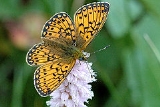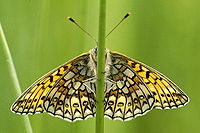
Boloria eunomia
Encyclopedia
The Bog Fritillary or Ocellate Bog Fritillary (Boloria eunomia) is a butterfly
of the Nymphalidae family.

. The males search for females in wet areas. The butterfly has the subspecies
triclaris (from Newfoundland
to Alberta
), nichollae (Alberta), and denali (Alaska
and northern Yukon
). The butterfly flies close to the ground. The species is listed as vulnerable. They eat nectar from flowers including Labrador tea
and goldenrod
. The species flies from the end of May till the beginning of August. The butterfly can be identified form similar species by looking on the hindwing underside; this species is the only one with a row of silvery submarginal spots.
including the Balkan Mountains
of Bulgaria
and one isolated population in Serbia
. The species is not mentioned in the Red Data Book of Serbian butterflies
because it was not known to be in the country at the time of it being published. The species is commonly found in open acid bog
s in areas that are moist. It can also be found in moist tundra
and willow seeps.
plant leaves. When the egg
s hatch in 7 to 8 days and after hatching, they feed on the underside of the leaves on the host plant. Caterpillar
s in Colorado
and Wyoming
are reddish-brown with red spines, with third or fourth instar
s hibernating. The caterpillars feed on Viola species and willow
s. The caterpillars can be found from April to June. The caterpillars are silver-gray with white dots.
Butterfly
A butterfly is a mainly day-flying insect of the order Lepidoptera, which includes the butterflies and moths. Like other holometabolous insects, the butterfly's life cycle consists of four parts: egg, larva, pupa and adult. Most species are diurnal. Butterflies have large, often brightly coloured...
of the Nymphalidae family.

Description
The wings are orange-brown with dark markings. The color of the hindwings are orangish-brown with a tan postmedian band followed by a row of round silver spots. The length of the forewings is 20–24 mm. The butterfly may be threatened by bog hydrologyHydrology
Hydrology is the study of the movement, distribution, and quality of water on Earth and other planets, including the hydrologic cycle, water resources and environmental watershed sustainability...
. The males search for females in wet areas. The butterfly has the subspecies
Subspecies
Subspecies in biological classification, is either a taxonomic rank subordinate to species, ora taxonomic unit in that rank . A subspecies cannot be recognized in isolation: a species will either be recognized as having no subspecies at all or two or more, never just one...
triclaris (from Newfoundland
Newfoundland and Labrador
Newfoundland and Labrador is the easternmost province of Canada. Situated in the country's Atlantic region, it incorporates the island of Newfoundland and mainland Labrador with a combined area of . As of April 2011, the province's estimated population is 508,400...
to Alberta
Alberta
Alberta is a province of Canada. It had an estimated population of 3.7 million in 2010 making it the most populous of Canada's three prairie provinces...
), nichollae (Alberta), and denali (Alaska
Alaska
Alaska is the largest state in the United States by area. It is situated in the northwest extremity of the North American continent, with Canada to the east, the Arctic Ocean to the north, and the Pacific Ocean to the west and south, with Russia further west across the Bering Strait...
and northern Yukon
Yukon
Yukon is the westernmost and smallest of Canada's three federal territories. It was named after the Yukon River. The word Yukon means "Great River" in Gwich’in....
). The butterfly flies close to the ground. The species is listed as vulnerable. They eat nectar from flowers including Labrador tea
Labrador tea
Labrador tea is a name commonly applied to three closely related species:* Rhododendron tomentosum ,...
and goldenrod
Goldenrod
Solidago, commonly called goldenrods, is a genus of about 100 species of flowering plants in the family Asteraceae. Most are herbaceous perennial species found in the meadows and pastures, along roads, ditches and waste areas in North America. There are also a few species native to Mexico, South...
. The species flies from the end of May till the beginning of August. The butterfly can be identified form similar species by looking on the hindwing underside; this species is the only one with a row of silvery submarginal spots.
Habitat
It is found throughout the north-temperate region of the Northern HemisphereNorthern Hemisphere
The Northern Hemisphere is the half of a planet that is north of its equator—the word hemisphere literally means “half sphere”. It is also that half of the celestial sphere north of the celestial equator...
including the Balkan Mountains
Balkan Mountains
The Balkan mountain range is a mountain range in the eastern part of the Balkan Peninsula. The Balkan range runs 560 km from the Vrashka Chuka Peak on the border between Bulgaria and eastern Serbia eastward through central Bulgaria to Cape Emine on the Black Sea...
of Bulgaria
Bulgaria
Bulgaria , officially the Republic of Bulgaria , is a parliamentary democracy within a unitary constitutional republic in Southeast Europe. The country borders Romania to the north, Serbia and Macedonia to the west, Greece and Turkey to the south, as well as the Black Sea to the east...
and one isolated population in Serbia
Serbia
Serbia , officially the Republic of Serbia , is a landlocked country located at the crossroads of Central and Southeast Europe, covering the southern part of the Carpathian basin and the central part of the Balkans...
. The species is not mentioned in the Red Data Book of Serbian butterflies
IUCN Red List
The IUCN Red List of Threatened Species , founded in 1963, is the world's most comprehensive inventory of the global conservation status of biological species. The International Union for Conservation of Nature is the world's main authority on the conservation status of species...
because it was not known to be in the country at the time of it being published. The species is commonly found in open acid bog
Bog
A bog, quagmire or mire is a wetland that accumulates acidic peat, a deposit of dead plant material—often mosses or, in Arctic climates, lichens....
s in areas that are moist. It can also be found in moist tundra
Tundra
In physical geography, tundra is a biome where the tree growth is hindered by low temperatures and short growing seasons. The term tundra comes through Russian тундра from the Kildin Sami word tūndâr "uplands," "treeless mountain tract." There are three types of tundra: Arctic tundra, alpine...
and willow seeps.
Caterpillars
The eggs are laid in groups of 2 to 4 under the hostHost (biology)
In biology, a host is an organism that harbors a parasite, or a mutual or commensal symbiont, typically providing nourishment and shelter. In botany, a host plant is one that supplies food resources and substrate for certain insects or other fauna...
plant leaves. When the egg
Egg (biology)
An egg is an organic vessel in which an embryo first begins to develop. In most birds, reptiles, insects, molluscs, fish, and monotremes, an egg is the zygote, resulting from fertilization of the ovum, which is expelled from the body and permitted to develop outside the body until the developing...
s hatch in 7 to 8 days and after hatching, they feed on the underside of the leaves on the host plant. Caterpillar
Caterpillar
Caterpillars are the larval form of members of the order Lepidoptera . They are mostly herbivorous in food habit, although some species are insectivorous. Caterpillars are voracious feeders and many of them are considered to be pests in agriculture...
s in Colorado
Colorado
Colorado is a U.S. state that encompasses much of the Rocky Mountains as well as the northeastern portion of the Colorado Plateau and the western edge of the Great Plains...
and Wyoming
Wyoming
Wyoming is a state in the mountain region of the Western United States. The western two thirds of the state is covered mostly with the mountain ranges and rangelands in the foothills of the Eastern Rocky Mountains, while the eastern third of the state is high elevation prairie known as the High...
are reddish-brown with red spines, with third or fourth instar
Instar
An instar is a developmental stage of arthropods, such as insects, between each molt , until sexual maturity is reached. Arthropods must shed the exoskeleton in order to grow or assume a new form. Differences between instars can often be seen in altered body proportions, colors, patterns, or...
s hibernating. The caterpillars feed on Viola species and willow
Willow
Willows, sallows, and osiers form the genus Salix, around 400 species of deciduous trees and shrubs, found primarily on moist soils in cold and temperate regions of the Northern Hemisphere...
s. The caterpillars can be found from April to June. The caterpillars are silver-gray with white dots.

